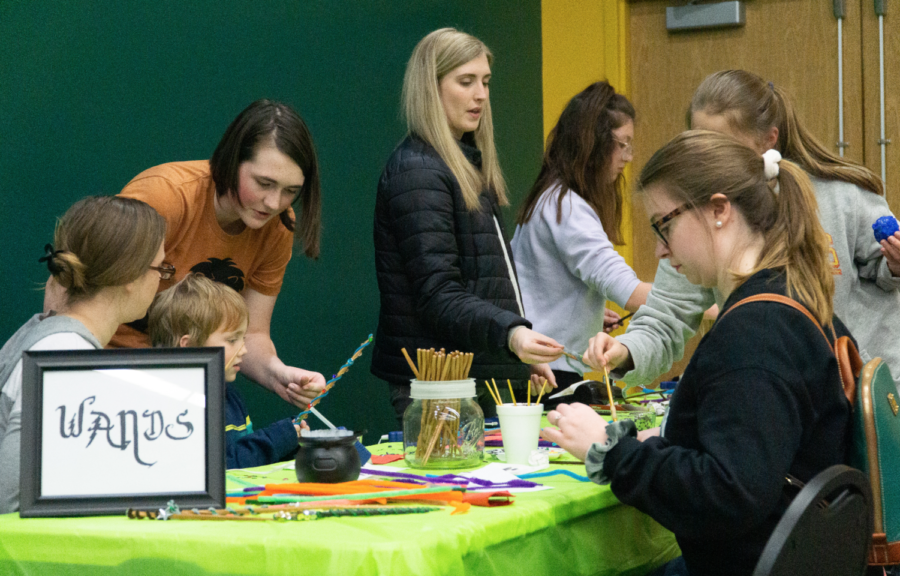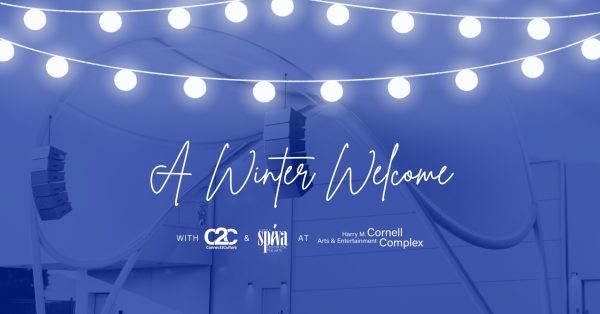English department recreates the magic of Harry Potter series
Students design wands at the Crafty Concoctions on Monday Mar. 2 at the North End Zone Facility.
The North End Zone was swarmed with wildlife Monday. Snakes were slithering all over people, there was a tortoise crawling around, and owls could be heard by people walking around the building.
The wildlife were part of Creature Studies and Crafty Concoctions, an event put together by Missouri Southern’s English department. The event was part of Harry Potter week, which is a week of celebrating the famous series by J.K. Rowling.
Harry Potter is this year’s theme for Literature Week.
Creature Studies and Crafty Concoctions was arranged in collaboration with professors from the biology and art departments, including poetry readings, as well a presentation by docents from Dickerson Park Zoo in Springfield.
Assistant professor of Biology & Environmental Health Dr. David Penning brought a variety of creatures to the event, including four snakes, a red-footed tortoise named Cleveland, and a turtle named Big Alabama.
“[I] have a group of animals [I’ll] take out to events with children or the public so they can see and experience wildlife, a little more close-up than what they normally would, to kind of demystify [the animals],” Penning said.
Their booth, called the Southern Slytherins, also included amphibians from the 1960s and 3D printed bear skulls.
In addition to the name of the booth, which incorporates one of the Harry Potter wizard houses, Penning also conceptually tied it with the inclusion of snakes.
“The first book [which includes] the basilisk,” Penning said.
In the series, the Basilisk is a giant serpent bred by Dark Wizards. While real, basilisks are not the slithering foe as described in the series, but a species of lizard.
“We have really neat wildlife and animal diversity here,” Penning said. “And we should talk about how they are quite special as well. We don’t need a fantasy world to see this really neat stuff, and so we can see sort of the magic in the life around us currently.”
A goal of his for the booth was to allow the public to learn more about the animals, experience them up close and demystify snakes.
Later in the evening, Pheobe Burke, junior art major, spent some time holding the snakes.
“Snakes aren’t as horrifying as people make them out to be, and they definitely aren’t slimy,” Burke said. “Think of a cool, bendable piece of plastic with some texture and that’s about it. They are very curious and absolutely adorable.
“One of them even liked how soft my hair was and climbed on my head. It was amazing and I had a great night learning about them.”
There were also owl presentations held by docents Ann Liles and Kim Smith from the Dickerson Park Zoo in Springfield.
They presented a screech owl and a great horned owl. Docents taught the audience a bit about the owls’ history and their habits.
“[The presentation was] very informative and fascinating to see owls upfront and close as they naturally are without it being on a screen or just a photograph. The handlers were really knowledgeable and kind,” Burke said. “I learned [the owls’] nocturnal habits and varying calls they have, which was fascinating.”
Another part of the Creature Studies and Crafty Concoctions included Dr. James Willand’s expertise herbs.
Willand, assistant department chair and associate professor of biology & environmental health, set up a table with herbs for participants to learn about and seed to take home with them.
He said that although herbs are considered aromatic or are often included in food, but it is a term for a wide variety of plants. The herbs he chose for this activity are ones he thought might be used in the books or in some form of magic.
The activity that he planned was for participants to seed plants to take home and care for. This could help introduce anyone to gardening, even people who didn’t necessarily have a green thumb.
Willand said that even for people with less gardening experience, it is important to keep the soil moist and the plant exposed to sunlight.
Some of the herbs included are basil, cilantro, parsley, lavender, chives, rosemary and thyme.
“My interest was to show you can grow a lot in a small space and you don’t necessarily have to have a big yard or garden,” Willand said. “You can have a lot of stuff that you might want to add to your meals [growing] just inside your house.”
Students, faculty and community members also came to take a little bit of the magic of Harry Potter home with them.
“It really is important for visual creativity to coincide with learning about literature, especially for kids,” said Jade Henning-Cantrell, administrator at Spiva Center for the Arts and Southern alumna. “So much of this book series can be appreciated in an artful way, and I think this event was a wonderful way for people of all ages to experience that.”
Your donation will support the student journalists of Missouri Southern State University. Your contribution will allow us to purchase equipment and cover our annual website hosting costs.




















